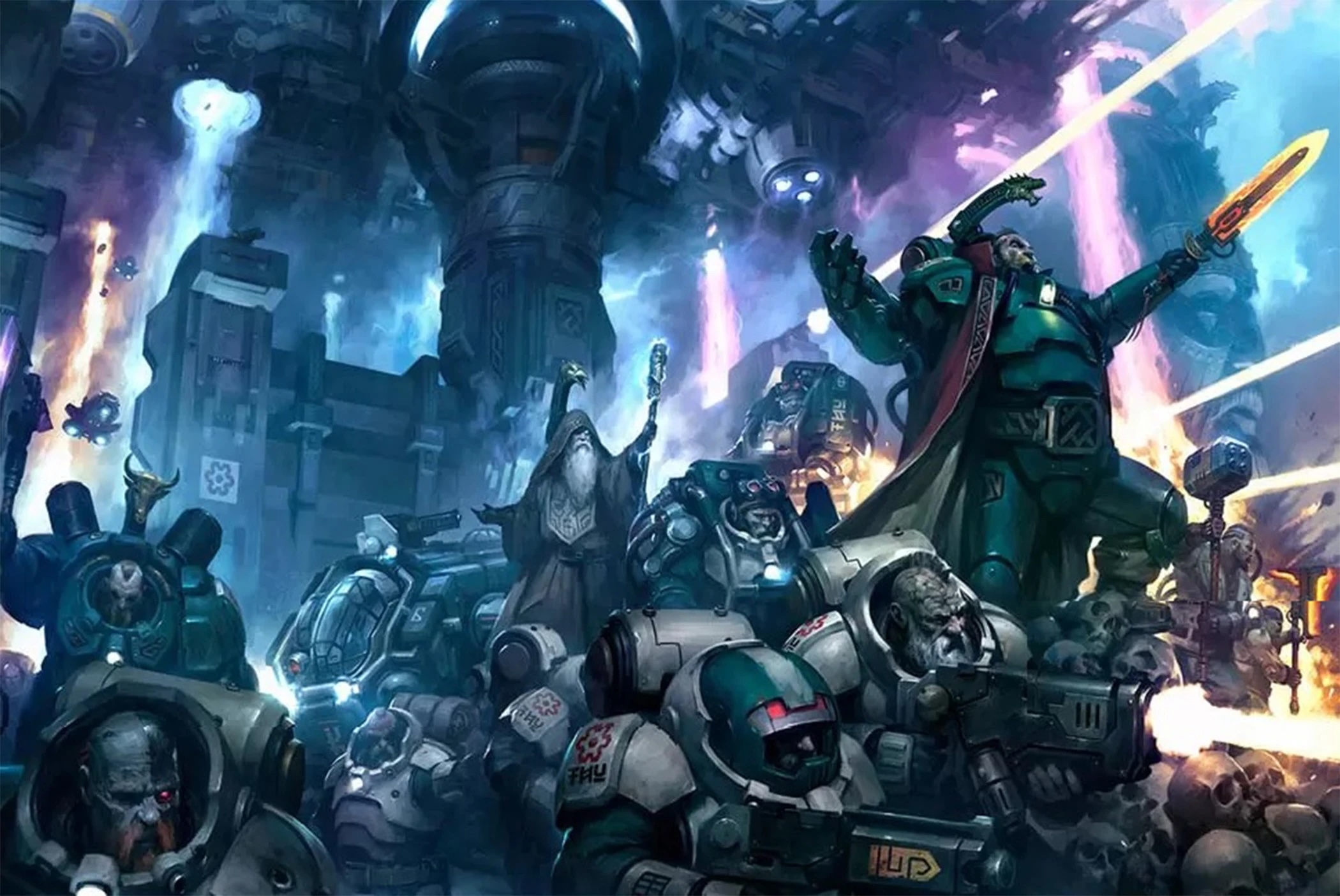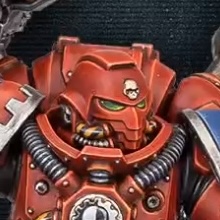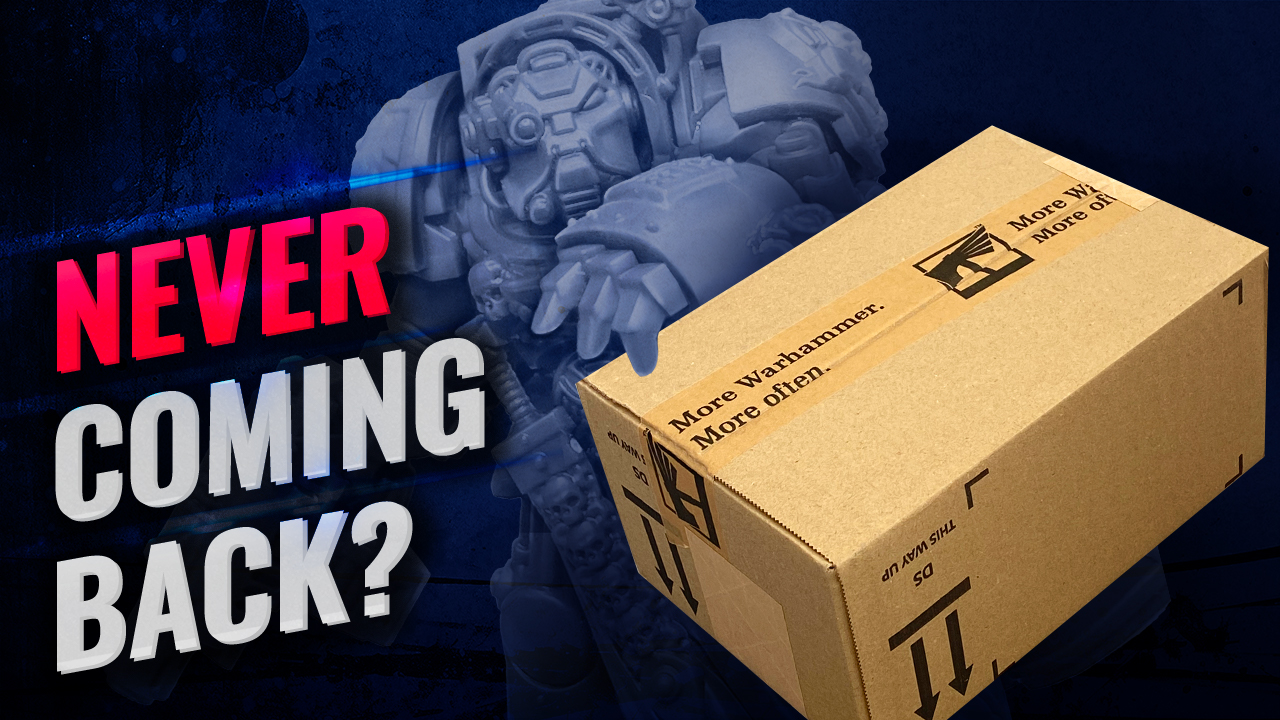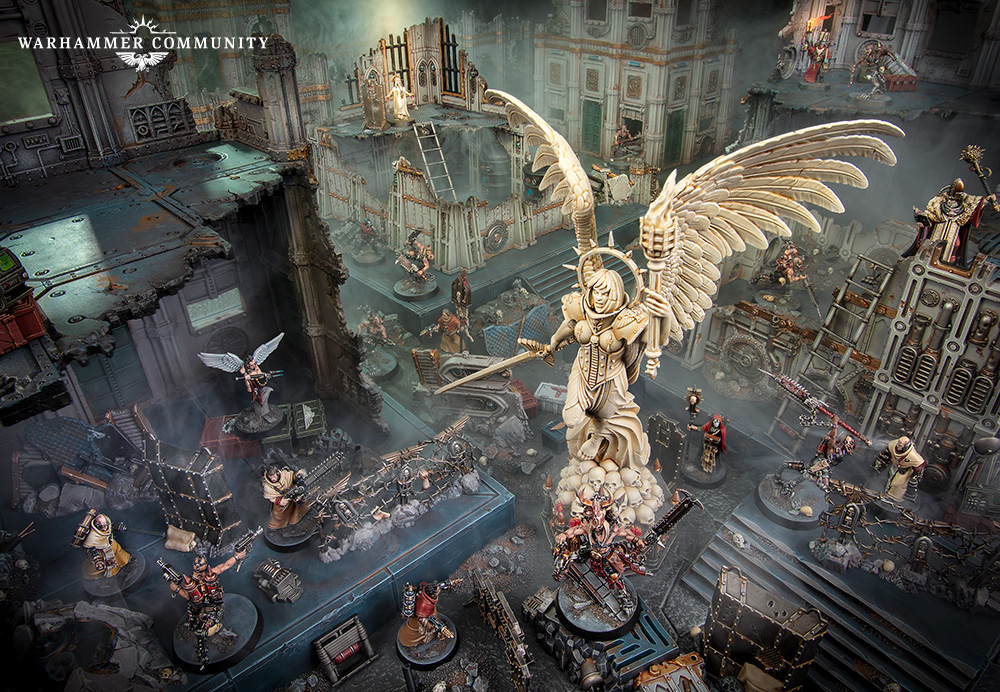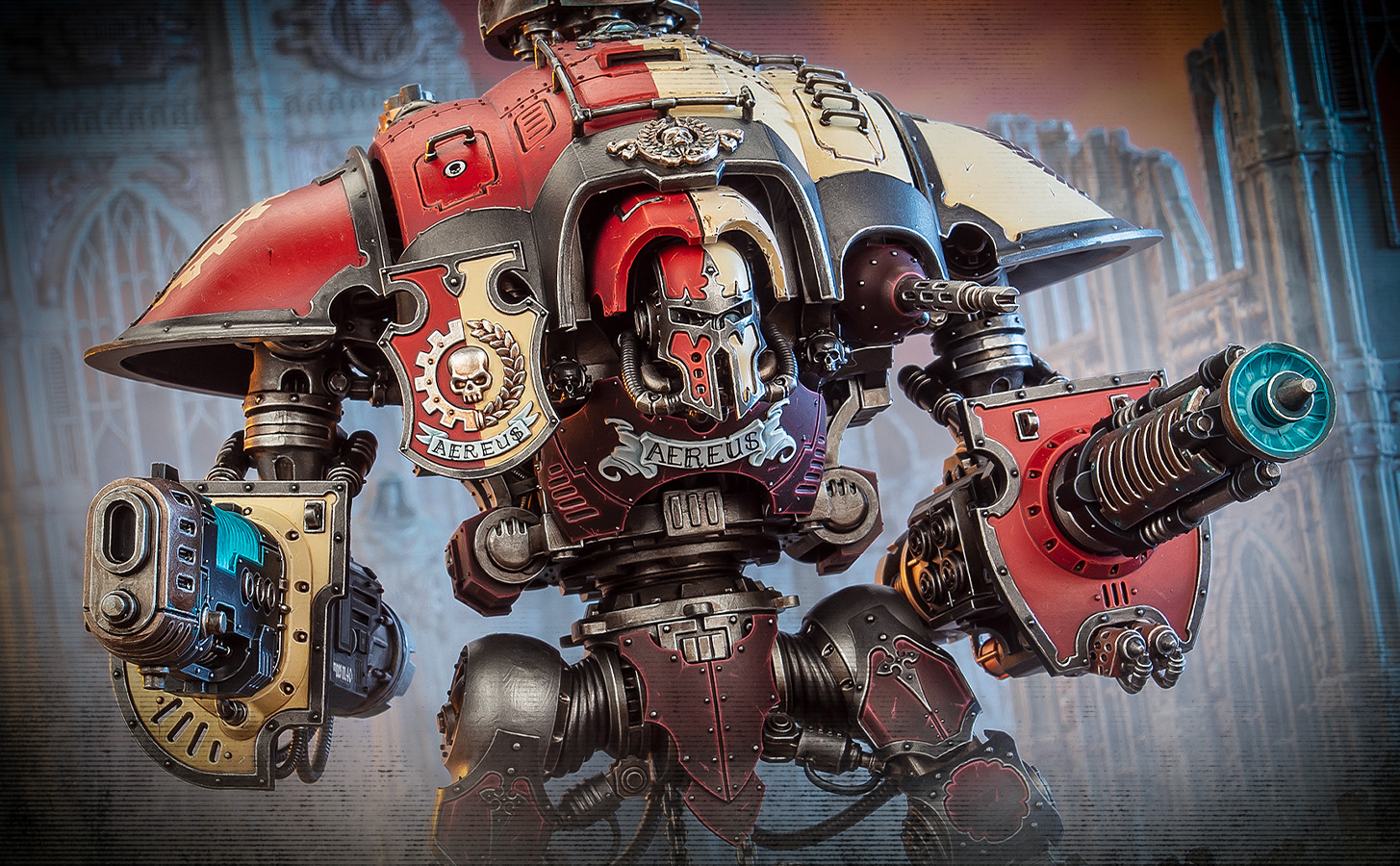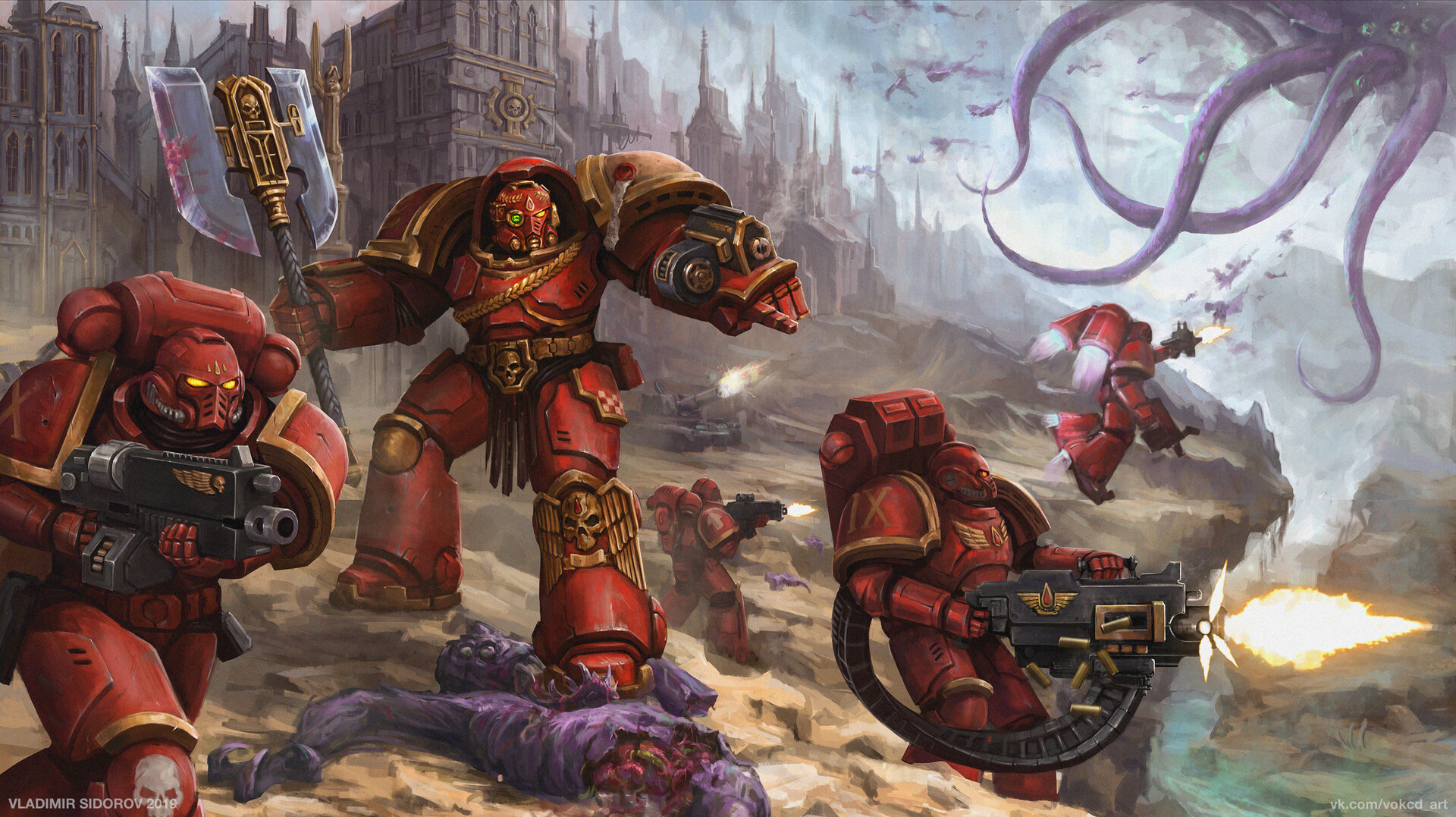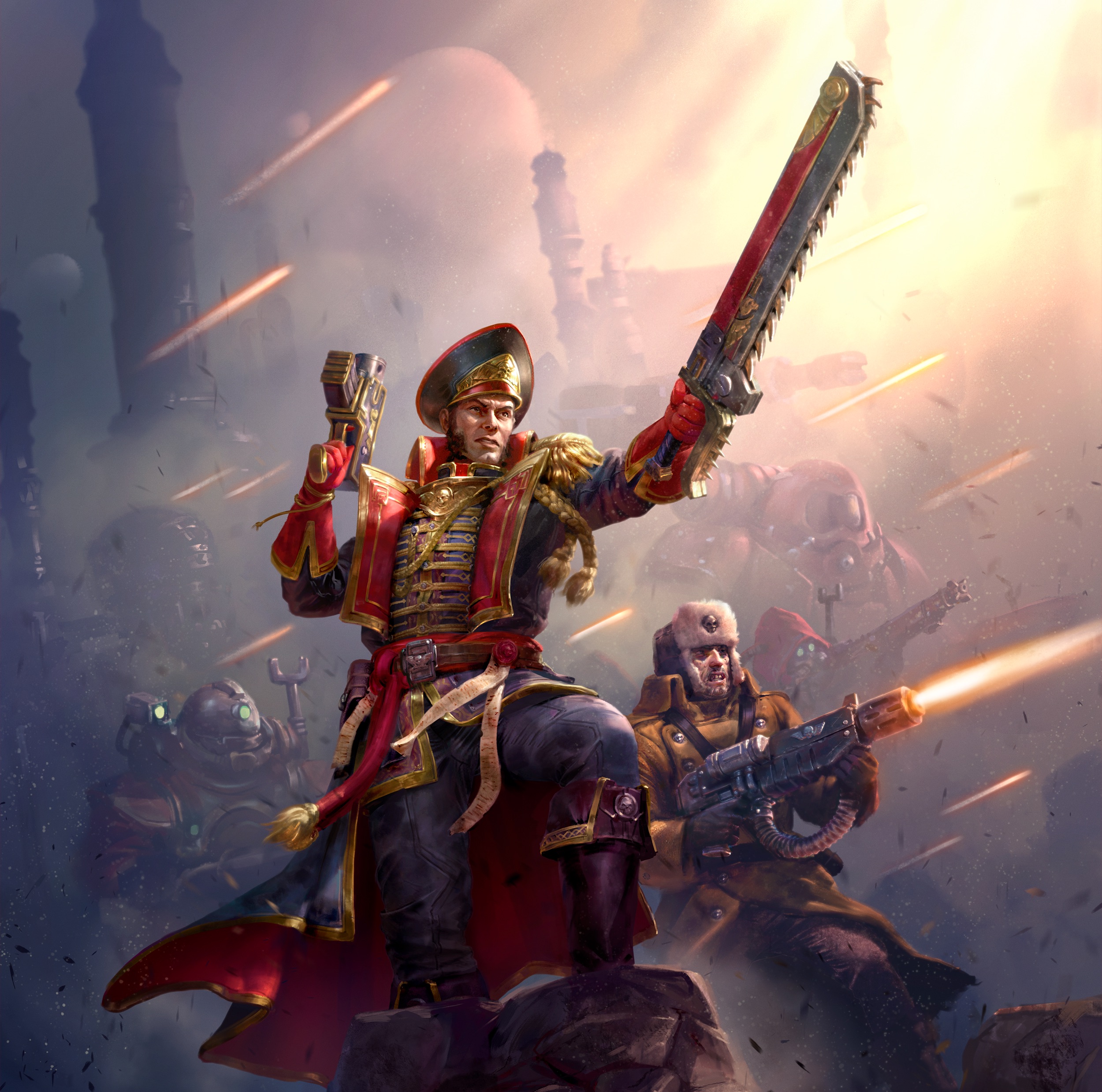Leagues of Votann, or the Kin, are an ancient offshoot of humanity that has only recently returned to the wider galactic stage. Descended from long-lost colonists and often derisively called “Squats,” the Kin established powerful confederations in the galactic core beyond Imperial reach.
They are short, stocky Abhuman clones who built a technologically advanced civilization guided by secretive machine intelligences known as the Votann (Ancestor Cores). Once thought a myth, the Leagues of Votann have re-emerged during the tumultuous Era Indomitus, armed with ancestral knowledge and formidable weaponry. This guide explores their origins, society, technology, recent return, and enigmatic role in the Warhammer 40K universe.
Origins and History
Humanity’s first expansion during the Dark Age of Technology planted the seeds of the Kin. Millennia ago, hardy pioneers from Old Earth ventured to the mineral-rich galactic core – a region difficult to reach and rife with heavy gravity, radiation, and warp storms.
Isolated from the rest of mankind, these settlers evolved into a distinct culture and species. The Kin are not aliens but an Abhuman lineage: their earliest records link them to pre-Imperial Terra’s generational mining fleets, meaning they diverged from baseline humans long before the Imperium’s rise. Over generations in harsh conditions, they underwent both natural genetic drift and deliberate bio-engineering, becoming a clone race optimized for survival in the core’s extremes.
The Kin’s genetic evolution was guided by advanced science. Each new generation is grown in artificial wombs called crucibles, using vast genomic databanks to ensure healthy variation. Stable mutations known as Cloneskeins were introduced to strengthen the species – denser musculature and bone, high radiation resistance, and efficient physiology far beyond normal humans.
As a result, Kin stand only about 4 feet tall but are immensely strong and durable, with some nearly matching a Space Marine’s raw power. Their engineered genes even dim their psychic presence: Kin almost never produce uncontrolled psykers and are naturally resilient to Warp influences. This means few Kin fall to mutation or daemon possession, giving them a built-in safeguard against Chaos corruption.
Cut off from the rest of humanity (likely by the Age of Strife’s warp storms), the Kin developed independently in the core. Rather than rejoin the nascent Imperium, their forebears chose to remain among the dense stars and asteroid fields, exploiting the boundless mineral wealth there.
For thousands of standard years, the Leagues of Votann have thrived in that tumultuous region, mining and colonizing where others could not. They established countless fortified colony holdings (called Holds) on high-gravity worlds and orbital platforms amid swirling cosmic storms.
Life in the core was unforgiving – a single missed maintenance task or wasted resource could mean extinction for a void-faring fleet. This fostered a rugged survivalist culture obsessed with self-reliance and efficiency. To the Kin, waste and negligence are the worst sins, born of hard lessons in the deadly vacuum of space. Every asteroid mined and every tank of air recycled could mean the difference between prosperity and death for their Kindreds.
Where other starfaring civilizations faltered in the galactic core’s extreme environment, the Kin endured and expanded. Their fleets of miners (the Cthonian Mining Guilds) became adept at insane feats of engineering: disassembling newborn stars to harvest exotic elements, cracking whole planets apart for ore, and scooping up raw cosmic radiation to fuel their industries.
Over time, the scattered Holds banded together into greater alliances for mutual defense and trade. These confederations became the Leagues of Votann – each a stellar nation of Kindreds sharing common cause. By the time the Imperium first brushed the core, the Kin had built a rich domain hidden behind hazardous warp phenomena and dense stellar debris.
Although largely isolationist, the Kin were never truly forgotten. Throughout history, intrepid bands of Kin did venture beyond the core. Bold prospectors mounted expeditions (called Prospects) into the wider galaxy, seeking knowledge and resources to bring home.
Some even fought as mercenaries among other species’ wars, honoring a cultural drive to “live a full life” and gather experience to enrich their ancestors. Because of this, fragmentary reports of short, squat miners and mercenaries cropped up across the galaxy.
However, outsiders rarely grasped the true scale of Kin civilization. Many thought a single Kindred they met was an isolated abhuman strain or minor xenos. The Kin were content to keep their existence low-profile, revealing little of their origins.
Even Imperial records note various encounters with “Squat” abhumans or the secretive “Demiurg”, not realizing these were all part of one great people. The Leagues saw no benefit in enlightenment – indeed, they feared Imperial zealots would impose Imperial rule or tech‐heresy laws if the Kin’s heritage were fully known. Thus, for ages the Kin hovered at the periphery of galactic events: trading rare minerals here, hiring out as soldiers there, but mostly watching and hoarding knowledge.
Still, the Kin fought countless wars in defense of their realm. Their most ancient and hated foe are the Orks, whose crude empires also infest the galactic core. The Kin have battled Greenskin invasions repeatedly and developed a special loathing for their anarchic destruction. Many a Grudge – the Kin term for a blood-oath of vengeance – has been sworn against the Orks over generations.
Other threats tested the Leagues as well: Necron dynasties awoke beneath Kin mining sites, provoking deadly conflicts with those undying machines. Tyranids too have encroached; the Kin call them “the Bane”, respecting the Hive Fleets as apex predators even as they battle to harvest the invaders’ rich biomatter for themselves.
And of course, Humanity’s Imperium has at times collided with the Kin – sometimes as uneasy allies, other times as bitter enemies. Imperial commanders have variously classified the Kin as abhuman cousins or as xenos to be purged, depending on politics and paranoia.
Through all these trials, the Leagues of Votann persisted by sticking fiercely to their code of “Family, Duty, and Hearth” – a resolute unity against all threats.
The Votann and Kin Society
At the heart of Kin society lie their mysterious ancestral machine-complexes, the Votann. Also called Ancestor Cores, these AI supercomputers are as revered by the Kin as gods are in other cultures. Each major Kindred or League safeguards one of these ancient thinking machines, which date back to the first Long March colony fleets.
In Kin mythology, “Votann” is sometimes spoken of as a legendary ancestor or group of elders, but in truth the Votann are powerful artificial general intelligences built to store knowledge and guide the colonists. The Kin treat them with near-reverence – a secular cult of veneration surrounds the Ancestor Cores, for honoring one’s ancestors and their wisdom is a core Kin value. No Kin would ever allow harm to come to a Votann if it can be helped, and every Kin is prepared to die in defense of these “Ancestor-gods” of their people.
In practical terms, the Votann contain an immeasurable wealth of knowledge. These cogitator vaults hold everything from weapon schematics and Standard Template Construct designs, to scientific data, navigation charts, genealogy, and strategic wisdom. They were meant to be the guiding repositories of human knowledge for the colonists.
So advanced are the Votann that their internal energy fields even serve as localized warp beacons for Kin fleets, much like the Emperor’s Astronomican does for the Imperium. It is little wonder the Kin keep them secret – in the ignorant 41st millennium, such intact fonts of technology and AI would incite crusades of fear.
Indeed, the Adeptus Mechanicus regards sentient machines as heresy, and the Kin know outsiders would surely mistake the Votann for “silica animus” abominations or corrupt idols. Thus, the Kin never explain the Votann to outlanders. They use the name freely but refuse to clarify, letting strangers assume “Votann” is a deity or myth while the Kin alone understand its true nature.
Kin society is organized around Kindreds – tight-knit clan communities, each usually based in a single major Hold (a fortified mining complex or city). A Kindred is like a tribe or corporate-house, numbering anywhere from a few thousand Kin to millions on a rich Hold World. Each Kindred is largely autonomous, led by a council of elders known as the Hearthspake, and often headed in battle by a elected war-leader called a Kâhl.
Many Kindreds also include Grimnyr, the so-called “Living Ancestors,” who are Kin psykers trained to commune with the Votann and interpret their wisdom. The Grimnyr fulfill a role akin to priests or shamans, though the Kin would say they are experts interfacing with ancient machines rather than religious clerics.
In special chambers called Fanes – part shrine, part data-interface – the Grimnyr pose questions to the Ancestor Core and decipher the cryptic outputs. Every Hold has a Fane at its heart, a place of quiet reverence where Kin feel the “presence” of their Ancestors heavily. Culturally these are the closest thing the practical-minded Kin have to temples.
Multiple Kindreds bond together into larger coalitions known as Leagues. A League is analogous to a nation or great house, comprised of many allied Kindreds and united by allegiance to one of the treasured Votann cores. In fact, the first Leagues formed as protective alliances to defend the Ancestor Cores during the early expansions.
Each League’s Votann sits at the center of its identity – for example, the Greater Thurian League or Ymyr Conglomerate are named and renowned partly by the character of their Ancestor Cores. League governance is typically handled by councils (such as a Votannic Council composed of representatives from each Kindred’s Hearthspake).
Despite their clan divisions, all Kin share a remarkably homogenous culture thanks to common ancestry and the guiding hand of the Votann. They speak variants of the same harsh tongue and uphold the same core values instilled by their survivalist past.
Kin culture can be summarized as stoic, pragmatic, and fiercely loyal to family. They place enormous emphasis on duty to one’s Kindred and respect for the wisdom of elders (both living and ancestral). The Kin do not worship gods – unlike the deeply religious Imperium, the Kin have no use for deity figures like the Emperor or Chaos Gods. Their reverence is reserved for the Ancestors (both the literal uploaded minds of forebears and the mythic First Ancestors of yore) and for the Votann machines that embody that ancestral legacy.
In day-to-day life, Kin are blunt, businesslike folk. They value craftsmanship, productivity, and accumulation of useful knowledge or resources. Having endured conditions where one faulty part or one lazy worker could doom an entire ship, they have little patience for frivolity or inefficiency. Each Kin is expected to contribute to the Hearth and uphold the reputation of their clan. Even their sense of humor tends toward dry sarcasm and engineer’s wit.
One unique aspect of Kin society is their integration of artificial lifeforms called Ironkin. The Ironkin are self-aware robotic beings that live among the Kin as equals. They were there from the beginning – legend holds the original colony fleets included advanced machine constructs to aid the humans.
The Kin harbor no superstitions about AI; to them, an Ironkin comrade is as much a person as any flesh-and-blood cousin. Ironkin fulfill many roles (technicians, miners, even soldiers), and each has a distinct personality albeit bounded by certain behavioral core programming.
Together, the flesh-and-steel halves of the species make up the Kin as a whole people, and both organic and Ironkin share in the same rights and duties. This collaborative existence would scandalize the Imperium (which fears AI), so the Kin generally hide their Ironkin from outsiders’ view when possible. Nonetheless, the Kin-Ironkin partnership greatly boosts the efficiency of their society and military – a fact not lost on jealous Adeptus Mechanicus observers.
Despite their practical veneer, the Kin are not without honor or emotion. They keep extensive records of grievances and heroic deeds. When wronged deeply enough, Kin will invoke an ironbound Grudge, vowing to exterminate the offending foe no matter how long it takes. This is one of the few times Kin allow passion to overrule pragmatism – a serious Grudge can drive a Kindred or entire League to wage generations-long vendetta wars at all costs.
To outsiders, this obsessive revenge may seem contradictory to the Kin’s logical nature, but to the Kin it is about justice and ancestral duty. They believe the spirits of their Ancestors judge them harshly if they let great wrongs go unanswered. Famous examples include the Five Hundred Years’ War, when a league united to annihilate an Ork empire that had destroyed one of their cherished Votann cores – the campaign literally lasted five centuries until every last Ork was slain.
On the flip side, the highest punishment in Kin law is exile with one’s name struck from the Ancestor records. A criminal cast out in this way is denied the chance to “return to the Ancestors” after death – a fate considered worse than death itself for Kin, rendering their life’s memory meaningless. Such cultural facets show that, though calculating, the Kin deeply cherish the continuity and honor of their people.
Technology and Military Doctrine
Cut off from Terra during Old Night, the Leagues of Votann developed an advanced technological base entirely independent of the Imperium. In fact, their science and industry in many ways surpass the Imperium’s, having preserved a direct heritage from the Dark Age of Technology.
The Kin possess working Standard Template Construct systems and Men of Iron-level artificial intelligences, augmented by millennia of continuous research and development free from any anti-intellectual taboos. While the Imperium regressed into superstition during the Age of Strife, the Kin kept improving their machines.
The result is a military arsenal that makes Tech-priests both envious and fearful – Leagues of Votann weaponry is so advanced, it’s said to have tech-adepts itching to commit heresy just to study it. (Notably, the Tau’s sophisticated ion weapons were originally acquired through trade with the Kin, a sign of how far ahead Kin technology can be.)
Kin weaponry combines the robust practicality of human STC designs with refinements only possible through unfettered innovation. They employ everything from high-tech ballistic arms (such as the Autoch-pattern bolter) to directed-energy guns like the HYLas beam rifle.
Materials and craftsmanship are top-notch – Kin firearms and power tools are built to last for generations of hard use. Many of their arms incorporate advanced features: for example, Mass drivers and Magna-rail cannons that fire hyper-dense projectiles capable of punching through a tank in one shot, or Volkanite disintegrators and Etacarn plasma weapons that vaporize infantry in bursts of stellar energy.
Even standard issue guns like the Kin’s magna-pattern autocannons or HYLas autorumens boast superior rate of fire and armor penetration compared to Imperial equivalents, thanks to superior ammo and design.
The Kin are also fond of gravitic weapons – technology that manipulates gravity. They use graviton bombs and concussion grenades that can crush foes under local gravity spikes, as well as gravity engines in their vehicles.
Defensive gear is equally advanced: every Kin warrior wears Void Armor, a robust powered suit with built-in life support and often an energy field generator for additional protection. This makes even their basic troops remarkably durable.
The elite Kin fighters don massive exo-frames akin to Terminator armor. The Einhyr Hearthguard are clad in powered exo-armor that turns them into walking tanks, equipped with integrated shoulder mounts and custom melee weapons (like blazing plasma blade gauntlets or the dreaded concussion Mass Hammers). These squads serve as shock troops and bodyguards, able to breach starship corridors or hold choke points with equal ease.
Additionally, Kin wargear often incorporates ancestor-tech assistance. The HunTR (Hunter-Response) targeting system, for instance, links weapon optics with data from the Votann and sensor drones to give Kin marksmen unparalleled accuracy and threat identification on the battlefield. It’s not uncommon for a Kin gun or piece of armor to have a minor machine-spirit or Ironkin-grade cogitator aiding its user – a far cry from the crude spirits Imperial tech-priests placate.
In warfare, the Kin favor a balanced, combined-arms approach driven by discipline and pragmatism. They are not berserkers; every engagement is evaluated for profit, survival, or the settling of a grudge.
Kin forces (often called Kinhosts) typically deploy in well-organized Oathbands, which are expeditionary combat teams made up of a mix of unit types. An Oathband will include squads of tough Hearthkyn infantry supported by armored units and automated drones.
The Kin excel at defensive and mid-range firepower warfare – they will methodically advance under covering fire rather than reckless charges. Heavy vehicles form the backbone of their motor pool. The Hekaton Land Fortress is a prime example: a colossal land tank that carries troops and mounts multiple weapon systems, effectively a fortress on wheels.
For faster strikes, the Kin use Sagitaur armored transports (robust ATV-sized tanks) and flotillas of Hernkyn Pioneer bikes – hover trikes ridden by scout cavalry. These Pioneers exemplify Kin ingenuity, combining speed with firepower as they sweep ahead of the main force to flank enemies or secure resources. All Kin vehicles and starships are noted to have high-grade armor and shielding, making them deceptively tough; even the small hover trikes carry force shields and can zip through hostile fire.
Ironkin robots often accompany Kin units, augmenting their capabilities. In battle, an Ironkin might operate as an ordinance loader, a cybernetic sniper, or even a dedicated combat mech.
The presence of true AI-controlled units gives Kin armies a flexibility and efficiency the Imperium can only dream of. For example, Ironkin-managed attack drones can coordinate perfectly with living Kin squads without any miscommunication.
The Kin also make use of ancient war engines from their arsenal – automated SPDs (Self-Propelled Defenses) that serve as artillery, or perhaps mighty Thunderkyn exo-frames (exosuits piloted by Kin or Ironkin) wielding heavy mining lasers capable of gutting enemy armor.
Unlike Imperial armies bound by ritualistic doctrine, the Kin are willing to adapt tactics on the fly. Retreat and regroup is not shameful if it avoids unnecessary loss; likewise, diplomacy or trade is a valid “weapon” if it achieves the strategic goal. Their ultimate objective is often securing valuable resources or knowledge rather than sheer conquest of territory. This outlook can bewilder foes who expect blind glory-seeking.
That is not to say the Kin lack courage – when cornered or in service of a dire Grudge, they fight with the tenacity of ancient Terran badgers. A Kin battle-line under siege becomes a stubborn shieldwall, their stout warriors laying down withering overlapping fields of fire.
Thanks to their physiology and armor, Kin troops can absorb punishment that would fell ordinary humans. Their naturally low Warp presence also means enemy psychic attacks are less effective; it’s hard for a Chaos sorcerer to cloud the mind of a Kin or ignite their soul when the Kin’s soul hardly flickers in the Warp.
This makes Kin forces frustratingly hard for Chaos to corrupt or dominate. Indeed, in battles against Chaos cultists or daemons, Kin will often dispatch specially trained Grimnyr psykers wielding “Barrier-tech” staves that channel kinetic force and Warp-nullifying energies. These Living Ancestors use Clone-skein granted psychic abilities to bolster their allies’ defenses and shut down witchery – an invaluable edge when facing horrors from the Empyrean.
Overall, the Kin approach combat like everything else: with level-headed efficiency. They prefer to strike on their own terms or not at all. If a situation looks unprofitable or unwinnable, a Kin commander has no qualms about negotiating a truce or making a tactical withdrawal to fight another day.
But when the Kin do commit to battle, they do so wholeheartedly – all the more if bound by an Oath or Grudge. A Kindred going to war will bring forth their best craft and ancient heirloom weapons, each warrior striving to honor the Ancestors with valor and skill.
It is said that Kin warriors carry the “weight of the ancestors” into battle: the knowledge that upon death, their memories will join the Ancestor Core. This drives them to set an example worthy of remembrance. It also means Kin forces can sometimes take surprisingly daring risks in battle if great renown (or a great prize) is at stake – for a victory that echoes in the Votann is worth a hundred lesser wins.
The Return of the Kin
After millennia in the shadows, why are the Leagues of Votann emerging now? The answer lies in the epoch-shattering events of the 41st millennium’s dawn. The formation of the Great Rift – the massive Warp upheaval that split the galaxy in half – has shaken the Kin out of their long-held isolation.
The Rift’s birth (in M41.999) sent cascades of new Warp storms rippling through the galactic core, cutting off some Kin strongholds and opening passages out of the core that were long sealed. As the Imperium reels in the Era Indomitus, the Kin too face unprecedented challenges and opportunities beyond their traditional borders.
Suddenly, regions of space that were once safe havens are threatened by daemonic incursions spilling from the Cicatrix Maledictum. Other areas that were perilous Warp maelstroms have temporarily calmed, creating new corridors for travel and exploration. The Kin have been forced to contend with the wider galaxy, whether they wanted to or not.
At the same time, internal pressures push the Kin outward. The Votann Ancestor Cores, so long the bedrock of their society, are beginning to show their age. Many have become ponderous and slow to respond – some queries can take years or even centuries for a Votann to fully process.
Millenia of accumulated data (and the constant influx of deceased Kin minds uploaded into the cores) have started to tax the machines’ systems. In certain tragic cases, an Ancestor Core has even “gone insane” or degenerated, as with the fabled Mad Core left on a dead world after a Tyranid attack.
The Kin are practical – they recognize that their society must adapt or die. Some among the Leagues believe that venturing outward to recover lost technology or find solutions is now necessary to preserve their Ancestor Cores. Others simply see advantage in exploiting the chaos of the current age to expand Kin influence and wealth. Whatever the motive, more Kin fleets are now traveling beyond the core in numbers not seen in eons.
Encounters between the Kin and the major galactic powers are rapidly increasing. On the Imperial front, initial meetings have been a mix of cooperation and conflict. Some Kin oathbands have aided the Imperium’s armies against shared threats like Chaos, fighting as stalwart allies on worlds besieged by daemons.
Their combat prowess and technical aid have saved Imperial forces on occasion – though often in exchange for lucrative mining rights or material reward (the Kin rarely fight for free). Imperial commanders have been astonished by the Kin’s equipment, and whispers spread of “Squat” mercenaries wielding weapons that put Adeptus Mechanicus technology to shame.
Of course, not all exchanges are positive. Many Imperials, especially the Adeptus Mechanicus and zealous Inquisitors, view the Kin with deep suspicion. Discovering the Kin’s use of “abominable” AI or archaeotech can spark violent confrontations.
In some sectors, Imperial forces have outright attacked Kin prospecting fleets, declaring them heretical xenos. The Kin, for their part, treat the Imperium on a case-by-case basis – they have little love for Imperial dogma, but will honor a deal if one can be struck. They remember that they share human ancestry with the Imperials, yet they reject the Emperor’s authority over them.
Notably, Kin opinion of the Adeptus Mechanicus is especially low: the Kin see the Machine-Cult as a pack of ignorant, ritualistic hoarders who dangerously misunderstand technology. Thus, if a tech-priest tries to confiscate Kin artifacts or demand fealty to the Omnissiah, the Kin are quite willing to eliminate that priest and move on.
Beyond the Imperium, the Kin have had varied interactions. With the T’au Empire, there is a history of surprisingly cordial relations – at least with certain Leagues. The Kin’s mercantile sub-factions (like the Seran-Tok League) found profit in trading rare minerals and weapons to the T’au, who were eager to acquire superior Kin tech.
In fact, as mentioned, the T’au’s ion weaponry likely originated from Kin designs. However, as the T’au expand, territorial disputes have arisen. Of late, Kin warships have clashed with T’au fleets on the fringes of the Chalnath Expanse, showing the Kin will not hesitate to defend their claims even against those they once traded with.
Encounters with the Aeldari have similarly swung between trade and battle. The Craftworld Aeldari acknowledge the Kin as ancient beings (calling them “Heliosi Ancients” in their lore) and have on occasion engaged in mutually beneficial commerce or alliance.
Both races are long-lived (in the Kin’s case, as a culture rather than individuals) and pragmatic, which can make for respectful negotiation. Yet the Kin have zero tolerance for the treacheries of the Dark Eldar (Drukhari), and will eagerly join any crusade to scour those piratical slavers from realspace. To the Kin, the Drukhari’s sadistic wastefulness is anathema to all they value.
The surge of Chaotic activity from the Great Rift has inevitably pitted the Kin against the forces of Chaos in new theaters. The Kin’s inherent resistance to Warp corruption makes them stout opponents of Chaos – something not lost on Imperial scholars, who theorize the Kin could become critical allies in containing the demonic tide.
Indeed, there are reports of Kin armies bluntly outfighting Chaos Space Marines, as the traitors find their sorcery and terror tactics ineffective on the stolid clone-miners. The Kin remain puzzled (and disgusted) by humans who would worship Chaos; in Kin culture such self-destructive folly is virtually unheard of.
Thus, when facing Chaos cultists, the Kin prosecute war with a cleansing fervor, seeing them as madmen to put down. The only sliver of silver lining from the Great Rift, from the Kin perspective, is that the galaxy’s attention is so fixed on Chaos and xenos invasions that the Leagues of Votann can operate somewhat more openly without drawing immediate unified hostility.
All told, the Leagues of Votann have “returned” to the galactic map at a pivotal moment. Their emergence has started to shift the balance in certain war zones. On some worlds, Imperial commanders have been thankful for Kin intervention against Tyranids or Orks. On others, Imperial and Kin forces have come to blows due to mistrust or competition over resources.
The Kin have also begun reclaiming a few of their long-lost colonial outposts beyond the core, places abandoned since the Age of Strife. Reclaiming these often brings them into conflict with whoever currently occupies them (be it human planets that forgot their Squat past, or ork warlords squatting – pun intended – on Kin mining worlds).
Each encounter teaches the galaxy more about the Kin – and teaches the Kin more about this changed galaxy. Unlike the secretive Necrons who awoke around the same time, the Kin are willing to communicate and even cooperate if it suits them.
This has led to some fascinating battle alliances, such as Kin fighting alongside the Astra Militarum as auxiliary artillery (a call-back to the Squat allied units of ancient times), or allied with Craftworld Alaitoc to ambush a Chaos Knight titan. However, these are ad hoc arrangements; as a whole, the Leagues remain noncommittal and independent, charting their own course through the current turmoil.
Impact on the Warhammer 40K Setting
The reappearance of the Leagues of Votann adds a new and intriguing factor to the already complex grimdark setting. As a separate power bloc, the Kin could tip the scales in conflicts by allying with or opposing the Imperium and other races.
For the Imperium, the Kin represent both a potential salvation and a dire threat. On one hand, the Leagues embody humanity’s lost golden age – they have intact technology and knowledge that could greatly aid the Imperium’s survival. If relations improved, the Kin might share STC patterns to fix failing Imperial infrastructure, or provide desperately needed raw materials and firepower to embattled sectors.
On the other hand, the Mechanicus and Inquisition fear and hate what the Kin represent: abandoning the Imperial Creed and surviving just fine. The Kin’s free-thinking use of AI and science is heresy to Mars. This could easily lead to a catastrophic war if, say, an Imperial Crusade was launched to seize a Votann core (imagine the Archmagos’s lust for a functioning Men-of-Iron tier computer).
In such a scenario, the Imperium would find the Kin to be a far tougher nut to crack than most xenos – the Kin could potentially hold off Imperial forces or strike back in ways the Imperium isn’t prepared for, like sabotage with macro-tools or even economic warfare (denying the Imperium critical ores only the Kin can mine).
For xenos factions, the Kin might become unexpected allies of convenience. The T’au, who espouse a philosophy of cooperation (at least superficially), could attempt to formally bring a League or two into their Coalition – the Kin would make formidable additions to the “Greater Good.”
However, the Kin are unlikely to submit to anyone’s empire, valuing their autonomy too much. A more plausible alliance might be a military pact against mutual threats (for instance, a combined Kin-T’au task force fighting off a Tyranid Hive Fleet in the galactic east, each for their own reasons).
The Aeldari, facing extinction, might share common cause with the long-lived Kin to protect certain ancient sites or to contain the Necrons. Notably, the Necrons and Kin have clashed over tomb worlds in the core, so the Kin might actively join campaigns to curb Necron expansions – a development the Aeldari would welcome.
Conversely, the Kin’s hatred of Orks means any Ork warlord will find an implacable enemy in them. We may see epic grudges play out, such as a major Waaagh! being ground down because Kin fleets ambush the ork supply lines and systematically annihilate every greenskin-inhabited asteroid in a sector. In the past, the Orks have underestimated the “stunties” at their peril, and now with greater numbers the Kin could potentially crush some Ork empires that the Imperium never could.
The galactic core, once a relatively off-map region in lore, now becomes a hotbed of activity. The Kin hold numerous resource-rich systems there, effectively a hidden empire that’s now interacting with the rest of the galaxy.
This could mean new battlefronts as Chaos and Tyranids push into the core seeking fresh conquests. If a Daemon Primarch or a Hive Fleet decided to target the core, the ensuing war would be truly apocalyptic – and the outcome far from certain with the stalwart Kin prepared to defend their territory.
On the narrative side, the Kin also bring an archaeotech vibe to Warhammer 40K storytelling. Through them, we might learn more about the lost Age of Technology. Their Ancestor Cores could reveal hints of what ancient Terra sent them to find, or what calamity befell the original human empire.
Plot threads like the slow failing of the Votann cores create drama within Kin society – perhaps a desperate quest for a replacement logic-engine or some miraculous STC cure will drive a major storyline, pulling other factions into a race against time and each other.
Imagine an arc where Inquisitors, T’au scientists, and Kin Brôkhyr (engineer Guilds) all scramble to retrieve a Men of Iron artifact on some forbidden world; the outcome could forge new alliances or ignite new wars.
In the grimdark present, the Kin are already influencing events in subtle ways. For example, their mercenary bands (those Oathbands seeking knowledge and fortune) are popping up in war zones across the Imperium. Some fight as hired guns for Imperial governors, others sell their services to rogue traders, and a few might even strike deals with less savory factions (one can envision a shrewd Kin making a contract with an Ordo Xenos Inquisitor to hunt down a Genestealer cult, for the right price).
These small-scale interactions will steadily change how the denizens of the galaxy perceive the Kin. No longer just a rumor, the “Squats” are proving to be master artisans and warriors. Over time, this could lead to segments of humanity becoming more accepting of abhumans, or alternatively, could spur radical elements to push for their extermination before they grow too influential.
The Imperial policy toward the Kin is not yet fixed – it may teeter between alliance and aggression depending on how early encounters play out. This uncertainty itself adds tension to the setting: every meeting between Kin and Imperium has the potential to either gain humanity a friend with benefits or spark a devastating conflict.
Finally, the Leagues of Votann inject the “long view” into the Warhammer narrative. These are people who think in terms of centuries and have records spanning back to humanity’s golden age. They’re not driven by short-term survival in the same way as the Imperium, nor by cosmic ambition like Chaos or the Tyranids.
The Kin agenda is ultimately about the survival and prosperity of their Kin. In the current galactic crisis, they will do whatever is necessary to secure their species’ future – whether that’s hoarding resources, eliminating dire threats, or even forging an alliance with the Imperium (should a wise leader like Roboute Guilliman manage to earn their respect).
Their enigmatic Ancestor Cores continue to advise them, albeit ever more slowly and cryptically. Perhaps the Kin will heed some ancient prophecy stored in a Votann and take actions that surprise everyone. As a faction, the Leagues of Votann sit somewhat morally grey – not inherently evil, not crusading good guys, but pragmatic survivors.
This unique perspective could lead to stories where the Kin make hard choices that other factions would balk at, like sacrificing one world to save ten, or negotiating with a minor Chaos warlord to buy time to evacuate a sector (only to double-cross and destroy him later).
In the grim darkness of the far future, the return of the Kin adds depth to that darkness. They are a mirror of humanity’s past and perhaps a beacon toward an unconventional future – one where knowledge, not faith, guides a civilization.
Whether they will stand with the Imperium against the coming horrors or pursue their own destiny apart remains to be seen. One thing is certain: the Leagues of Votann will not fade away again. The Kin have survived horrors unimaginable, and now that they stride forth from the galactic core with volcannons blazing and axes held high, they intend to claim their place in the galaxy’s saga – by the Ancestors’ will, and with hearts of adamant, they will endure whatever the future brings.
